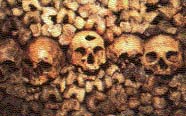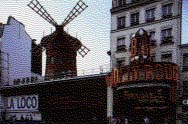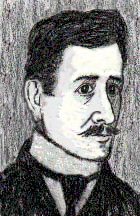

Famous Cases | Historical Tales | Vampires | Zombies
 |
 |
Famous Cases | Historical Tales | Vampires | Zombies |
 |
| Paris' eerie catacombs |
Like fellow painter Toulouse-Lautrec, Steketee's preferred subject was the nightlife around his atelier in Montmartre. He painted prostitutes, dancing girls, beggars...and vampires. While other artists had painted vampires from memory, Steketee was the first to have them sit for portraits. Despite the danger, Steketee painted over a dozen vampire portraits, and with each one his sense of ease grew. In July of 1892, a vampire suggested to him that Paris' underground catacombs, with their stacks of skulls and bones, would be a more atmospheric backdrop for the portrait; Steketee foolishly followed him there and was set upon by a hunting pack.
 |
| Moulin Rouge |
 |
| Steketee in an 1890 self-portrait |
With public sentiment on his side, Steketee was released into the care of Madame Mauriello, a wealthy widower and devoted follower. She set him up in her Tuileries mansion, where he continued his crusade, speaking to huge crowds and winning support from politicians and religious leaders.
 |
| Mme. Mauriello's mansion the day after the fire |
The arrangement was shortlived. Early on the morning of December 12th, 1892, a terrified girl arrived in the police station claiming that she had narrowly escaped the clutches of a vampire. Police officers followed her back to the Mauriello mansion and discovered the pack. Word spread, and for the second time in his life, Lucien Steketee found himself hiding out from an angry mob. But this time, there was no escape: the mob burned the mansion to the ground, with Steketee, Mme. Mauriello and the young vampires inside.
Steketee's body was never found, leading to speculation that he had escaped; a suspicion strengthened during World War II, when several members of the French Resistance reported seeing a man resembling Steketee prowling the sewers. To this day, he is said to emerge from underground on the anniversary of his death to claim a victim. Which is why, before nightfall on December 12th, suspicious Parisians hang garlic and crosses over their doorways.